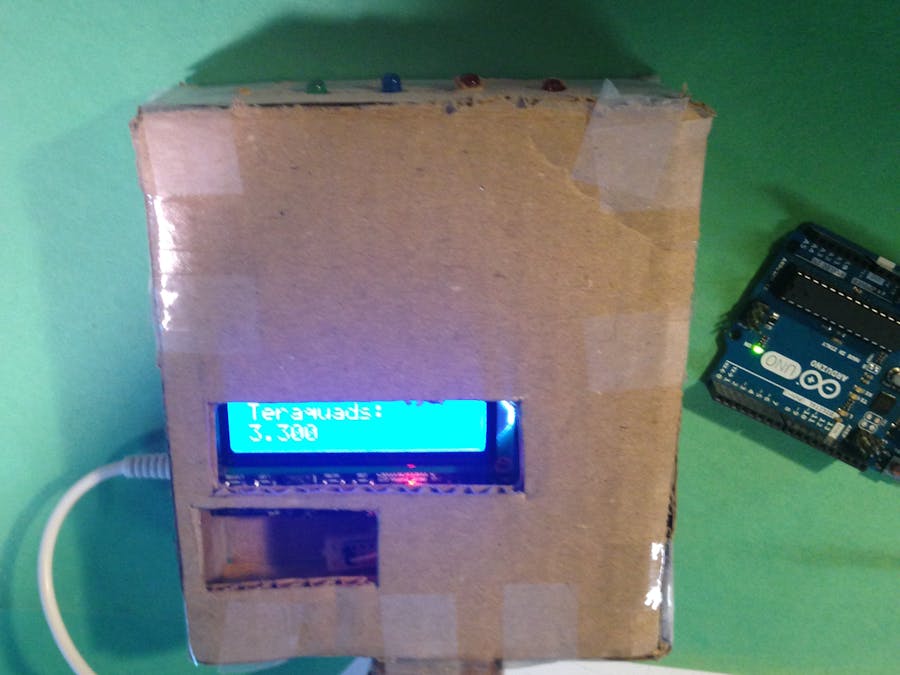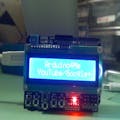Hardware components | ||||||
_wzec989qrF.jpg?auto=compress%2Cformat&w=48&h=48&fit=fill&bg=ffffff) |
| × | 1 | |||
 |
| × | 4 | |||
 |
| × | 5 | |||
 |
| × | 1 | |||
 |
| × | 1 | |||
| × | 1 | ||||
Hand tools and fabrication machines | ||||||
 |
| |||||
I was looking at my Star Trek tricorder one day, and I thought "I wonder if I could build this using an Arduino". I searched the internet for weeks trying to find someone else who had built one, but I couldn't even find ONE Arduino tricorder!
So, I decided to venture out, and try and build one of my own.
I began by soldering the LEDs.
Soldering the LEDs to a power jumper, and grounding them
Once I did that, I soldered the buzzer.
LEDs and buzzer soldered to power jumpers, and grounded.
Then, I built a temporary case for everything out of cardboard.
Temporary cardboard case for the circuitry
A few days later, I decided to also add in a thermister, so that I could "scan" for the temperature. Rather than soldering the thermistor, I just used a rail from a breadboard. And, I also added a "pocket" for the 9V battery.
Thermistor and 9V pocket
And then, I added a front panel to make it look more user-friendly.
Finished prototype
#include <LiquidCrystal.h>
#include <math.h>
// Initialize the library with the numbers of the interface pins
LiquidCrystal lcd(8, 9, 4, 5, 6, 7);
//States for the menu.
int currentMenuItem = 0;
int lastState = 0;
void setup() {
//Set the characters and column numbers.
lcd.begin(16, 2);
//Print default title.
clearPrintTitle();
}
double Thermister(int RawADC) { //Function to perform the fancy math of the Steinhart-Hart equation
double Temp;
Temp = log(((10240000/RawADC) - 10000));
Temp = 1 / (0.001129148 + (0.000234125 + (0.0000000876741 * Temp * Temp ))* Temp );
Temp = Temp + 273.15; // Convert Kelvin to Celsius
Temp = (Temp * 9.0)/ 5.0 + 32.0; // Celsius to Fahrenheit - comment out this line if you need Celsius
return Temp;
}
void loop() {
//Call the main menu.
mainMenu();
}
void mainMenu() {
//State = 0 every loop cycle.
int state = 0;
//Refresh the button pressed.
int x = analogRead (0);
//Set the Row 0, Col 0 position.
lcd.setCursor(0,0);
//Check analog values from LCD Keypad Shield
if (x < 100) {
//Right
} else if (x < 200) {
//Up
state = 1;
} else if (x < 400){
//Down
state = 2;
} else if (x < 600){
//Left
} else if (x < 800){
//Select
state = 3;
}
//If we are out of bounds on th menu then reset it.
if (currentMenuItem < 0 || currentMenuItem > 4) {
currentMenuItem = 0;
}
//If we have changed Index, saves re-draws.
if (state != lastState) {
if (state == 1) {
//If Up
currentMenuItem = currentMenuItem - 1;
displayMenu(currentMenuItem);
} else if (state == 2) {
//If Down
currentMenuItem = currentMenuItem + 1;
displayMenu(currentMenuItem);
} else if (state == 3) {
//If Selected
selectMenu(currentMenuItem);
}
//Save the last State to compare.
lastState = state;
}
//Small delay
delay(5);
}
//Display Menu Option based on Index.
void displayMenu(int x) {
switch (x) {
case 1:
clearPrintTitle();
lcd.print ("Bio Scan");
break;
case 2:
clearPrintTitle();
lcd.print ("Firmware Scan");
break;
case 3:
clearPrintTitle();
lcd.print ("Temperature Scan");
break;
case 4:
clearPrintTitle();
lcd.print ("Geo Scan");
break;
case 5:
clearPrintTitle();
lcd.print ("General Scan");
break;
}
}
//Print a basic header on Row 1.
void clearPrintTitle() {
lcd.clear();
lcd.setCursor(0,0);
lcd.print("Starfleet");
lcd.setCursor(0,1);
}
void scanMode() {
lcd.clear();
lcd.setCursor(0,0);
}
void ledDelay(){
const int buzzerPin1 = 26;
//led pins (in order): 22 23 24 25
digitalWrite(22, HIGH);
delay(100);
digitalWrite(22, LOW);
digitalWrite(23, HIGH);
delay(100);
digitalWrite(23, LOW);
digitalWrite(24, HIGH);
delay(100);
digitalWrite(24, LOW);
digitalWrite(25, HIGH);
delay(100);
digitalWrite(25, LOW);
digitalWrite(22, HIGH);
delay(100);
digitalWrite(22, LOW);
digitalWrite(23, HIGH);
delay(100);
digitalWrite(23, LOW);
digitalWrite(24, HIGH);
delay(100);
digitalWrite(24, LOW);
digitalWrite(25, HIGH);
delay(100);
digitalWrite(25, LOW);
tone(buzzerPin1, 700);
delay(70);
noTone(buzzerPin1);
delay(70);
tone(buzzerPin1, 700);
delay(70);
noTone(buzzerPin1);
}
void ledDelay2(){
const int buzzerPin1 = 26;
//led pins (in order): 22 23 24 25
digitalWrite(23, HIGH);
digitalWrite(24, HIGH);
delay(200);
digitalWrite(23, LOW);
digitalWrite(24, LOW);
delay(150);
digitalWrite(22, HIGH);
digitalWrite(25, HIGH);
delay(200);
digitalWrite(22, LOW);
digitalWrite(25, LOW);
delay(150);
digitalWrite(23, HIGH);
digitalWrite(24, HIGH);
delay(200);
digitalWrite(23, LOW);
digitalWrite(24, LOW);
delay(150);
digitalWrite(22, HIGH);
digitalWrite(25, HIGH);
delay(200);
digitalWrite(22, LOW);
digitalWrite(25, LOW);
tone(buzzerPin1, 700);
delay(70);
noTone(buzzerPin1);
delay(70);
tone(buzzerPin1, 700);
delay(70);
noTone(buzzerPin1);
}
//Show the selection on Screen.
void selectMenu(int x) {
randomSeed(analogRead(14));
int scanResults = random(6, 1000);
int a = 0;
int scanResults2 = random(0, 3);
switch (x) {
case 1:
scanMode();
lcd.print ("Bio scan ");
lcd.setCursor(0,1);
lcd.print("initiated");
ledDelay();
lcd.print(".");
ledDelay();
lcd.print(".");
ledDelay();
lcd.print(".");
ledDelay();
scanMode();
lcd.print ("Bio scan ");
lcd.setCursor(0,1);
lcd.print("completed");
ledDelay();
scanMode();
lcd.print ("Life signs: ");
lcd.setCursor(0,1);
lcd.print(scanResults);
lcd.setCursor(1,1);
lcd.print(".");
lcd.setCursor(2,1);
lcd.print(scanResults);
//Call the function that belongs to Option 1
break;
case 2:
while (a == 0){
/*scanMode();
lcd.print ("Firmware scan ");
lcd.setCursor(0,1);
lcd.print("initiated");
ledDelay2();
lcd.print(".");
ledDelay2();
lcd.print(".");
ledDelay2();
lcd.print(".");
ledDelay2();
scanMode();
lcd.print ("Firmware scan ");
lcd.setCursor(0,1);
lcd.print("completed");
ledDelay2();*/
ledDelay2();
scanMode();
lcd.print ("Teraquads: ");
lcd.setCursor(0,1);
lcd.print(scanResults);
lcd.setCursor(1,1);
lcd.print(".");
lcd.setCursor(2,1);
lcd.print(scanResults);
}
//Call the function that belongs to Option 2
break;
case 3:
while (a == 0) {
digitalWrite(22, HIGH);
delay(100);
digitalWrite(22, LOW);
digitalWrite(23, HIGH);
delay(100);
digitalWrite(23, LOW);
digitalWrite(24, HIGH);
delay(100);
digitalWrite(24, LOW);
digitalWrite(25, HIGH);
delay(100);
digitalWrite(25, LOW);
digitalWrite(22, HIGH);
delay(100);
digitalWrite(22, LOW);
digitalWrite(23, HIGH);
delay(100);
digitalWrite(23, LOW);
digitalWrite(24, HIGH);
delay(100);
digitalWrite(24, LOW);
digitalWrite(25, HIGH);
delay(100);
digitalWrite(25, LOW);
scanMode();
int val; //Create an integer variable
double temp; //Variable to hold a temperature value
val=analogRead(15); //Read the analog port 0 and store the value in val
temp=Thermister(val); //Runs the fancy math on the raw analog value
lcd.setCursor(0,0);
lcd.print("Temperature:");
lcd.setCursor(0,1);
lcd.print(temp - 900); //Print the value to the serial port
lcd.setCursor(6,1);
lcd.print("(F)");
delay(100);
}
break;
case 4:
scanMode();
lcd.print ("Geological scan ");
lcd.setCursor(0,1);
lcd.print("initiated");
ledDelay();
lcd.print(".");
ledDelay();
lcd.print(".");
ledDelay();
lcd.print(".");
ledDelay();
scanMode();
lcd.print ("Geological scan ");
lcd.setCursor(0,1);
lcd.print("completed");
ledDelay();
scanMode();
lcd.print ("Dilithium: ");
lcd.setCursor(0,1);
lcd.print(scanResults);
lcd.setCursor(1,1);
lcd.print(".");
lcd.setCursor(2,1);
lcd.print(scanResults);
//Call the function that belongs to Option 4
break;
case 5:
scanMode();
lcd.print("Location");
//Call the function that belongs to Option 4
break;
}
}
1 project • 1 follower
In 2015, I began teaching a class called the Pi Crafters. This class teaches kids how to program in HTML, CSS, Arduino, and Python.
Thanks to Steve from Hackshed.








Comments
Please log in or sign up to comment.